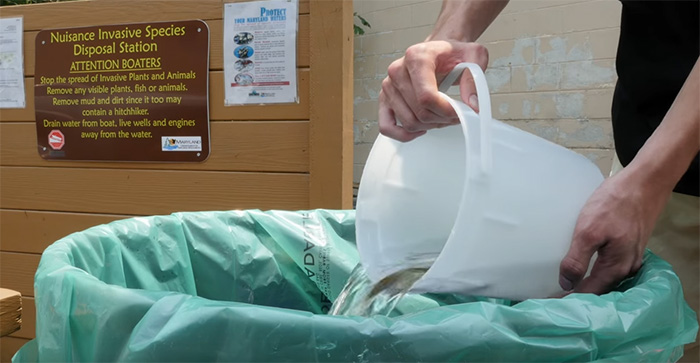Invasive species are any species that are non-native and harm the local ecosystem. When these non-native plants and animals establish themselves in our local ecosystems, they outcompete and dislodge species that have evolved specifically to live there and the careful disposal of live bait is one way to keep certain invasives from becoming established.

Live bait introductions, sometimes called bait bucket dumps, are instances where an angler releases unused live bait into or near the water or, for terrestrial baits, on land. While anglers may believe this as a kind or humane act, it can actually be quite harmful. People may assume the bait they purchased originally came from just down the road, but the reality is much of the bait being sold has been shipped from across the United States or even from another country and can contain non-native or even invasive species. Even the vegetation or soil that bait is packed in can hold non-native species or harbor diseases that can be harmful to our aquatic and terrestrial ecosystems.
Bait bucket releases have led to the introductions of non-native or invasive species all over North America and is certainly a pressing issue here in Maryland as well. Every body of water in Maryland, from the Chesapeake Bay to a small pond, is at risk for these introductions. Even small streams not usually fished could be affected by live bait introduced further downstream.
From an industry standpoint, the best live bait grows and reproduces quickly and can survive variable conditions during transport and in bait shops. Unfortunately, these traits can make these same species ideal for invasion and I’ll list a few examples.
Rusty Crayfish excel at disrupting native ecosystems as their populations easily outcompete native crayfish and they are known to prey heavily on the eggs of gamefish. Goldfish may seem harmless in a tank, but if released, they uproot aquatic vegetation, thereby decreasing habitat quality and releasing sediment to downstream waters. Lastly, while all earthworms tend to look similar, the worms sold as bait are often non-native to Maryland and can negatively affect soil and in turn, many of the plants and animals which rely on it.
MDNR has put a lot of effort into outreach to Maryland anglers to inform them of the risks that the live bait they use may pose to our ecosystems. The simple act of releasing unused bait may impact Maryland aquatic ecosystems and reduce the quality of the fisheries anglers enjoy. MDNR also conducts extensive monitoring of Maryland waters to detect new, novel introductions. MDNR also has conducted recent surveys of anglers, bait vendors, and wholesale bait suppliers to gain fresh insight on the live bait available and being used in Maryland.
Anglers can help protect our waters with the simple habit of never releasing any live bait, such as fish, worms, crayfish, etc. MDNR recommends that anglers give unused bait to a fellow angler, dispose of bait and packing material humanely by freezing it, or disposing of it in a trash can away from any waterbody. As an agency, we can implement regulations and suggest recommendations, but anglers are our best line of defense against these introductions.
If you have any questions, please contact your local DNR biologist or
check out our invasive species content.